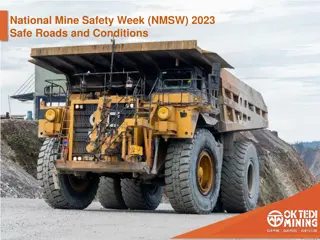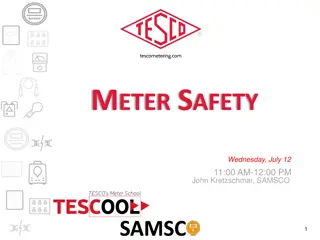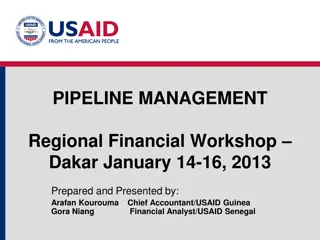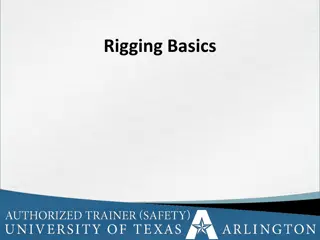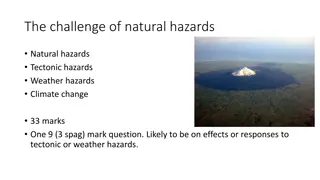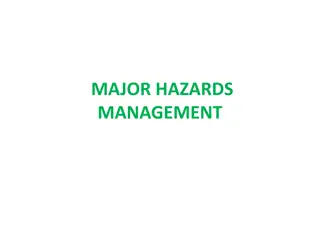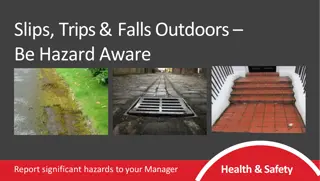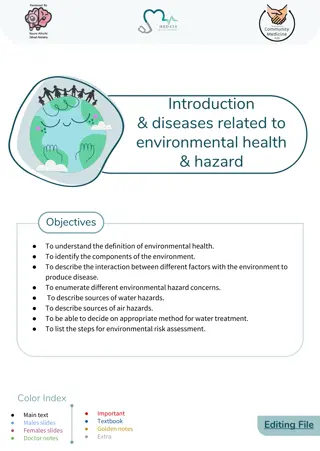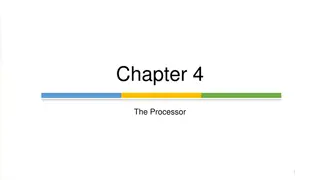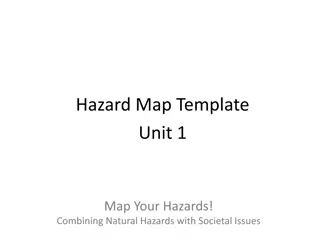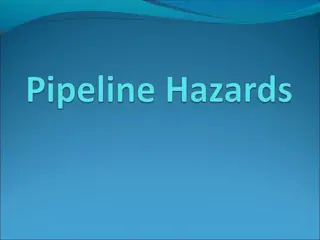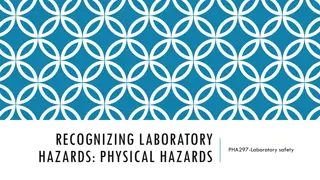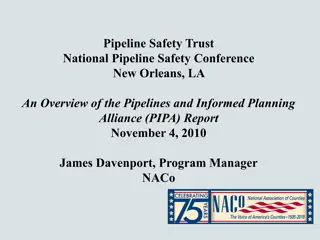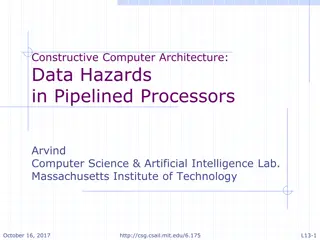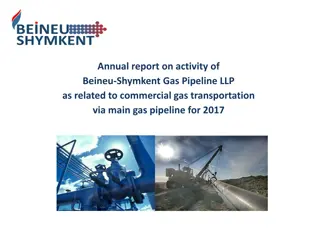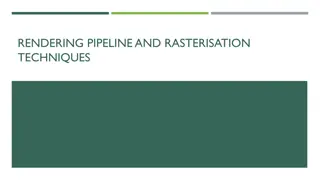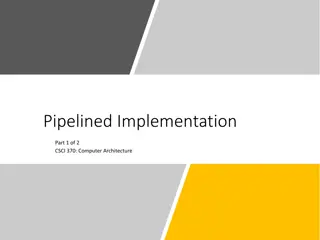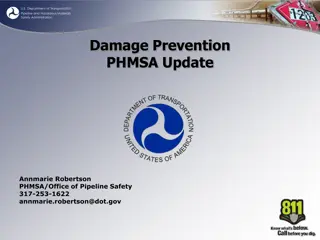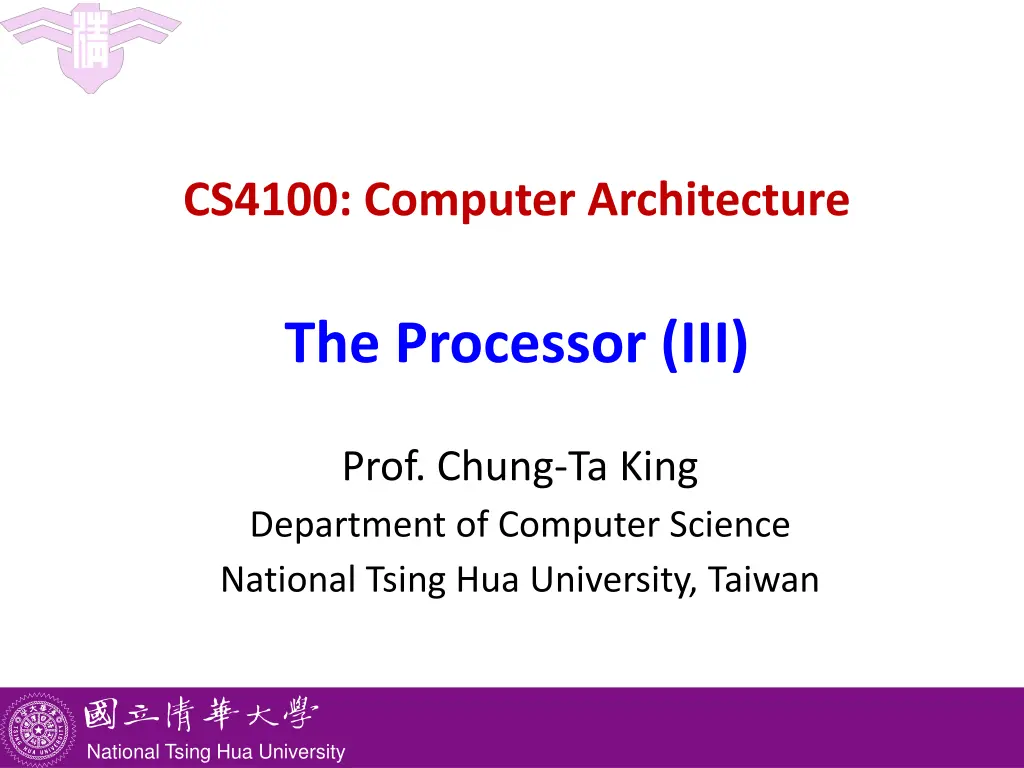
Understanding Pipeline Hazards in Computer Architecture
Explore the concept of pipeline hazards in computer architecture, covering structure hazards, data hazards, and control hazards in processors. Learn how these challenges impact instruction execution and how to mitigate them effectively.
Download Presentation

Please find below an Image/Link to download the presentation.
The content on the website is provided AS IS for your information and personal use only. It may not be sold, licensed, or shared on other websites without obtaining consent from the author. If you encounter any issues during the download, it is possible that the publisher has removed the file from their server.
You are allowed to download the files provided on this website for personal or commercial use, subject to the condition that they are used lawfully. All files are the property of their respective owners.
The content on the website is provided AS IS for your information and personal use only. It may not be sold, licensed, or shared on other websites without obtaining consent from the author.
E N D
Presentation Transcript
CS4100: Computer Architecture The Processor (III) Prof. Chung-Ta King Department of Computer Science National Tsing Hua University, Taiwan National Tsing Hua University
Outline Problem statement and logic review (Sec. 4.1, 4.2) Building a simple RISC-V processor with datapath and control (Sec. 4.3, 4.4) Building a pipelined RISC-V processor with datapath and control (Sec. 4.5, 4.6) Dealing hazards in pipelined processor: data and control hazards (Sec. 4.7, 4.8) Handling exceptions (Sec. 4.9) More advanced topics: parallelism via instructions, ARM Cortex-A53 and Intel Core i7 Pipelines, instruction-level parallelism (Sec. 4.10, 4.11, 4.12) 1 National Tsing Hua University
Pipeline Hazards Situations that prevent starting the next instruction in the next cycle, e.g., add x19,x0,x1 sub x2,x19,x3 Note: Data flow between instructions through registers Time ALU add x19,x0,x1 IM DM Reg Reg sub x2,x19,x3 ALU IM DM Reg Reg sub would read old data 2 National Tsing Hua University
Three Types of Pipeline Hazards Structure hazards Conflict for use of a resource need to wait for previous instruction to complete so to use the resource Data hazard Need to wait for previous instruction to complete its data read/write so to use the storage (registers/memory) Control hazard Need to wait for previous control-flow instruction to complete to decide whether to execution Can always resolve hazards by waiting Pipeline control must detect the hazard Take action (or delay action) to resolve hazards 3 National Tsing Hua University
Structure Hazards Suppose RISC-V pipeline has only a single memory Load/store requires data access at its MEM stage The third following instruction in IF also requires memory Time ALU Mem Reg Mem Reg ld I n s t r. ALU Mem Mem Reg Reg Instr 1 ALU Mem Mem Reg Reg Instr 2 O r d e r ALU Mem Mem Reg Reg Instr 3 ALU Mem Mem Reg Reg Instr 4 Both instructions access memory at same cycle 4 National Tsing Hua University
Structure Hazards Suppose RISC-V pipeline has only a single memory The third following instruction would have to stall for that cycle cause a pipeline bubble Solution: use two memory (data, instruction memory) Or separate instruction/data caches ALU I-Mem D-Mem Reg Reg 5 National Tsing Hua University
Data Hazards An instruction depends on completion of data access to the same register by a previous instruction add x19, x0, x1 sub x2, x19, x3 Their overlapped execution in pipeline would cause the dependent instruction to fetch wrong data in registers Time ALU add x19,x0,x1 IM DM Reg Reg sub x2,x19,x3 ALU IM DM Reg Reg 6 National Tsing Hua University
Dependences and Data Hazards Data dependences between instructions may cause data hazards, depending on relative positions in pipe RAW (read after write): sub x2,x1,x3 and x6,x2,x5 WAR (write after read): sub x6,x2,x5 and x2,x1,x3 WAW (write after write): sub x2,x1,x3 and x2,x6,x5 i2 tries to read operand in the pipeline before i1 writes it get old data instead of new i2 tries to write operand in the pipeline before i1 reads it get new data instead of old i2 tries to write operand in the pipeline before i1 writes it leave wrong data 7 National Tsing Hua University
Data Hazards in RISC-V 5-Stage Pipeline WAR (write after read) and WAW (write after write) can t happen in RISC-V 5-stage pipeline because: All instructions take 5 stages Reads are always in stage 2 Writes are always in stage 5 Thanks to the regularity in RISC-V ISA design But, we still need to resolve RAW hazards RAW hazards may occur between different stages 8 National Tsing Hua University
RAW Hazards among Different Stages X2 = 10 sub x2,x1,x3 and x12,x2,x5 or x13,x6,x2 add x14,x2,x2 sw x15,100(x2) X2 = -20 No hazard: Write in 1st half cycle & read in 2nd half Fig. 4.50 9 National Tsing Hua University
Resolving Data Hazards Let dependent instruction wait until hazard is resolved, i.e., stall i2 until i1 writes back to register at the WB stage insert pipeline bubbles Better: forward data as soon as it is computed 10 National Tsing Hua University
Forwarding (Bypassing) Use result when it is computed, e.g., by ALU at the EX stage Don t wait for it to be stored in a register at WB stage Requires extra connections in the datapath X 11 National Tsing Hua University
Forwarding between Stages No hazard Fig. 4.51 12 National Tsing Hua University
Detecting the Need to Forward Pass register numbers along pipeline e.g., ID/EX.RegisterRs1 = register number for Rs1 sitting in ID/EX pipeline register ALU operand register numbers in EX stage given by ID/EX.RegisterRs1, ID/EX.RegisterRs2 Data hazards when 1a. EX/MEM.RegisterRd = ID/EX.RegisterRs1 or 1b. EX/MEM.RegisterRd = ID/EX.RegisterRs2 Fwd from EX/MEM pipeline reg Rd Rs1 Rs2 13 National Tsing Hua University
Detecting the Need to Forward Data hazards when (cont.) 2a. MEM/WB.RegisterRd = ID/EX.RegisterRs1 2b. MEM/WB.RegisterRd = ID/EX.RegisterRs2 Fwd from MEM/WB pipeline reg Rd Rs1 Rs2 14 National Tsing Hua University
Detecting the Need to Forward But data hazard will occur only if the forwarding instruction will write to a register! EX/MEM.RegWrite (for EX/MEM to ID/EX) MEM/WB.RegWrite (for MEM/WB to ID/EX) And only if Rd for that instruction is not x0 EX/MEM.RegisterRd 0 (for EX/MEM to ID/EX) MEM/WB.RegisterRd 0 (for MEM/WB to ID/EX) 15 National Tsing Hua University
Forwarding Paths EX hazard Rd Fig. 4.52 16 National Tsing Hua University
Forwarding Conditions EX hazard if (EX/MEM.RegWrite and (EX/MEM.RegisterRd 0) and (EX/MEM.RegisterRd = ID/EX.RegisterRs1)) ForwardA = 10 if (EX/MEM.RegWrite and (EX/MEM.RegisterRd 0) and (EX/MEM.RegisterRd = ID/EX.RegisterRs2)) ForwardB = 10 17 National Tsing Hua University
Forwarding Paths MEM hazard Rd Fig. 4.52 18 National Tsing Hua University
Forwarding Conditions MEM hazard if (MEM/WB.RegWrite and (MEM/WB.RegisterRd 0) and (MEM/WB.RegisterRd = ID/EX.RegisterRs1)) ForwardA = 01 if (MEM/WB.RegWrite and (MEM/WB.RegisterRd 0) and (MEM/WB.RegisterRd = ID/EX.RegisterRs2)) ForwardB = 01 But there is a problem 19 National Tsing Hua University
Double Data Hazards Consider the sequence: add x1,x1,x2 sub x1,x1,x3 and x1,x1,x4 Both hazards occur and both add and sub want to forward to and use the most recent, i.e., sub Thus, need to revise MEM hazard condition Forward only if EX hazard condition isn t true 20 National Tsing Hua University
Revised Forwarding Condition MEM hazard if (MEM/WB.RegWrite and (MEM/WB.RegisterRd 0) and not (EX/MEM.RegWrite and (EX/MEM.RegisterRd 0) and (EX/MEM.RegisterRd = ID/EX.RegisterRs1)) and (MEM/WB.RegisterRd = ID/EX.RegisterRs1)) ForwardA = 01 if (MEM/WB.RegWrite and (MEM/WB.RegisterRd 0) and not (EX/MEM.RegWrite and (EX/MEM.RegisterRd 0) and (EX/MEM.RegisterRd = ID/EX.RegisterRs2)) and (MEM/WB.RegisterRd = ID/EX.RegisterRs2)) ForwardB = 01 21 National Tsing Hua University
Datapath with Forwarding Fig. 4.54 22 National Tsing Hua University
Can't Always Forward ld can still cause a hazard: (load-use data hazard) If it is followed by an instruction to read the loaded reg. ld x2,20(x1) and x4,x2,x5 Need to stall for one cycle Fig. 4.56 23 National Tsing Hua University
Load-Use Hazard Detection Check when the using instruction is decoded in the ID stage (lw is in the EX stage) ALU operand register numbers in ID stage are given by IF/ID.RegisterRs1, IF/ID.RegisterRs2 Load-use hazard when ID/EX.MemRead and ((ID/EX.RegisterRd = IF/ID.RegisterRs1) or (ID/EX.RegisterRd = IF/ID.RegisterRs2)) Note that ID/EX.MemRead=1 indicates a load instruction If detected, stall and insert bubble 24 National Tsing Hua University
How to Stall an Instruction in the Pipeline? Stall pipeline by keeping instructions in same stage and inserting an NOP instead Stall inserted here Fig. 4.57 25 National Tsing Hua University
How to Stall the Pipeline? Stall instructions in IF and ID: Prevent update of PC and IF/ID register The using instruction is decoded again The following instruction is fetched again 1-cycle stall allows MEM to read data for ld Can subsequently forward to EX stage What to move into EX: Force control signals in ID/EX register to 0 Turn EX, MEM and WB into NOP (no-operation) As control signals propagate, all control signals to EX, MEM, WB are deasserted, no registers or memories are written 26 National Tsing Hua University
Datapath with Stalling Unit ID/EX.MemRead and ((ID/EX.Rt = IF/ID.Rs1) or (ID/EX.Rt = IF/ID.Rs2)) Force control values in ID/EX to 0 Prevent update of PC & IF/ID Fig. 4.58 27 National Tsing Hua University
Stalls and Performance Stalls reduce performance But are required to get correct results Compiler can arrange code to avoid hazards and stalls Requires knowledge of the pipeline structure C code for A = B + E; C = B + F; ld x1, 0(x0) ld x2, 8(x0) add x3, x1, x2 sd x3, 24(x0) ld x4, 16(x0) add x5, x1, x4 sd x5, 32(x0) ld ld ld add sd add sd x1, 0(x0) x2, 8(x0) x4, 16(x0) x3, x1, x2 x3, 24(x0) x5, x1, x4 x5, 32(x0) stall stall 13 cycles 11 cycles 28 National Tsing Hua University
Control Hazards Branch determines flow of control Fetching next instruction depends on branch outcome Pipeline can t always fetch correct instruction Still working on ID stage of branch Need to wait until branch outcome determined before fetching next instruction In RISC-V pipeline Need to compare registers and compute target early in the pipeline How early can we do it in the pipeline? 29 National Tsing Hua University
Control Hazards beq determines whether to branch at the MEM stage beq 30 National Tsing Hua University
Control Hazards When beq decides to branch, the following 3 instructions are already in pipeline! Fig. 4.59 Flush these instructions (Set control values to 0) PC 31 National Tsing Hua University
Reducing Branch Delay Add hardware to determine outcome at ID stage Check branch equality at ID (using XOR) Target address adder at ID stage Will still fetch the next sequential instruction add a control signal, IF.Flush, to zero instruction field of IF/ID (making the following instruction an NOP) Example: branch taken 36: sub x10, x4, x8 40: beq x1, x3, 16 // branch to 40+16*2=72 44: and x12, x2, x5 48: or x13, x2, x6 52: add x14, x4, x2 56: sub x15, x6, x7 ... 72: ld x4, 50(x7) 32 National Tsing Hua University
Example: Branch Taken Fig. 4.60 33 National Tsing Hua University
Example: Branch Taken Fig. 4.60 34 National Tsing Hua University
Example: Branch Taken Fig. 4.60 35 National Tsing Hua University
Data Hazards for Branches If a comparison register is a destination of 2nd or 3rd preceding ALU instruction add x1,x2,x3 IF ID EX MEM WB add x4,x5,x6 IF ID EX MEM WB IF ID EX MEM WB beq x1,x4,target IF ID EX MEM WB Can resolve using forwarding (how?) Need to forward to ID stage in addition to EX stage! 36 National Tsing Hua University
Data Hazards for Branches If a comparison register is a destination of preceding ALU instruction or 2nd preceding load instruction Need 1 stall cycle ld x1,addr IF ID EX MEM WB add x4,x5,x6 IF ID EX MEM WB beq stalled IF ID beq x1,x4,target ID EX MEM WB 37 National Tsing Hua University
Data Hazards for Branches If a comparison register is a destination of immediately preceding load instruction Need 2 stall cycles ld x1,addr IF ID EX MEM WB beq stalled IF ID beq stalled ID beq x1,x0,target ID EX MEM WB How to check the conditions and stall pipeline stage? 38 National Tsing Hua University
Handling Control Hazards Longer pipelines can t readily determine branch outcome early Stall penalty becomes unacceptable Option 1: dynamic branch prediction Predict outcome of branch Only stall if prediction is wrong Option 2: compiler rescheduling 39 National Tsing Hua University
Branch Prediction Static branch prediction Based on typical branch behavior Example: loop and if-statement branches Predict backward branches taken Predict forward branches not taken In RISC-V pipeline, can predict branches always not taken Fetch instruction after branch, with no delay Need to add hardware for flushing instructions if wrong Dynamic branch prediction Hardware measures actual branch behavior e.g., record recent history of each branch Assume future behavior will continue the trend When wrong, stall while re-fetching, and update history 40 National Tsing Hua University
Dynamic Branch Prediction Need to prediction two things: Branch direction Branch target Branch direction: Branch prediction buffer (branch history table), indexed by recent branch instruction addresses Stores outcome (taken/not taken) in the table To execute a branch Check table, expect the same outcome Start fetching from fall-through or target If wrong, flush pipeline and flip prediction 41 National Tsing Hua University
Predicting Branch Direction Predict branch based on past history of branch Branch History Table (BHT) PC Hash 2N entries . . . . . Table update N bits BHT: a cache of recent branches Each entry stores last direction that the indexed branch went (1 bit to encode taken/not-taken) No need to decode to know if it is a branch, just look at instr. address FSM Update Logic Actual outcome Prediction 42 National Tsing Hua University
Problem with 1-Bit Predictor Inner loop branches mispredicted twice! outer: inner: beq , , inner beq , , outer Mispredict as taken on last iteration of inner loop Then mispredict as not taken on first iteration of inner loop next time around 43 National Tsing Hua University
Solution: 2-Bit Predictor Change prediction on two successive mispredictions Fig. 4.61 44 National Tsing Hua University
Calculating the Branch Target Need target address at same time as prediction Branch Target Buffer (BTB): use PC to fetch instruction and simultaneously look up BTB to get prediction AND branch address (if taken) Branch PC PC of instruction Predicted PC Fetch Yes: instruction is branch and use predicted PC as next PC =? Branch predicted taken or untaken No: branch not predicted, proceed normally 45 National Tsing Hua University
Outline Problem statement and logic review (Sec. 4.1, 4.2) Building a simple RISC-V processor with datapath and control (Sec. 4.3, 4.4) Building a pipelined RISC-V processor with datapath and control (Sec. 4.5, 4.6) Dealing hazards in pipelined processor: data and control hazards (Sec. 4.7, 4.8) Handling exceptions (Sec. 4.9) More advanced topics: parallelism via instructions, ARM Cortex-A53 and Intel Core i7 Pipelines, instruction-level parallelism (Sec. 4.10, 4.11, 4.12) 46 National Tsing Hua University
Events and Interrupts What happen if CPU fetches an instruction and cannot understand its opcode? What happen if you type a key on the keyboard? How does the computer know and start processing your input? When these special events occur, the CPU needs to interrupt the currently executing program and switch to execute some special subroutines to handle the events 47 National Tsing Hua University
Exceptions and Interrupts Unexpected events requiring change in flow of control to service the events Similar to a procedure call, but unplanned Exception Arises within CPU, e.g., undefined opcode, overflow, syscall Interrupt From an external I/O controller 48 National Tsing Hua University
Detection of Exceptions and Interrupts How does the CPU know when there is an interrupt? Usually when it receives a signal from one of the IRQ (interrupt request) pins, which are connected to one or more external I/O controllers How about exceptions? CPU controller may raise a flag, e.g., undefined opcode, overflow, 49 National Tsing Hua University

